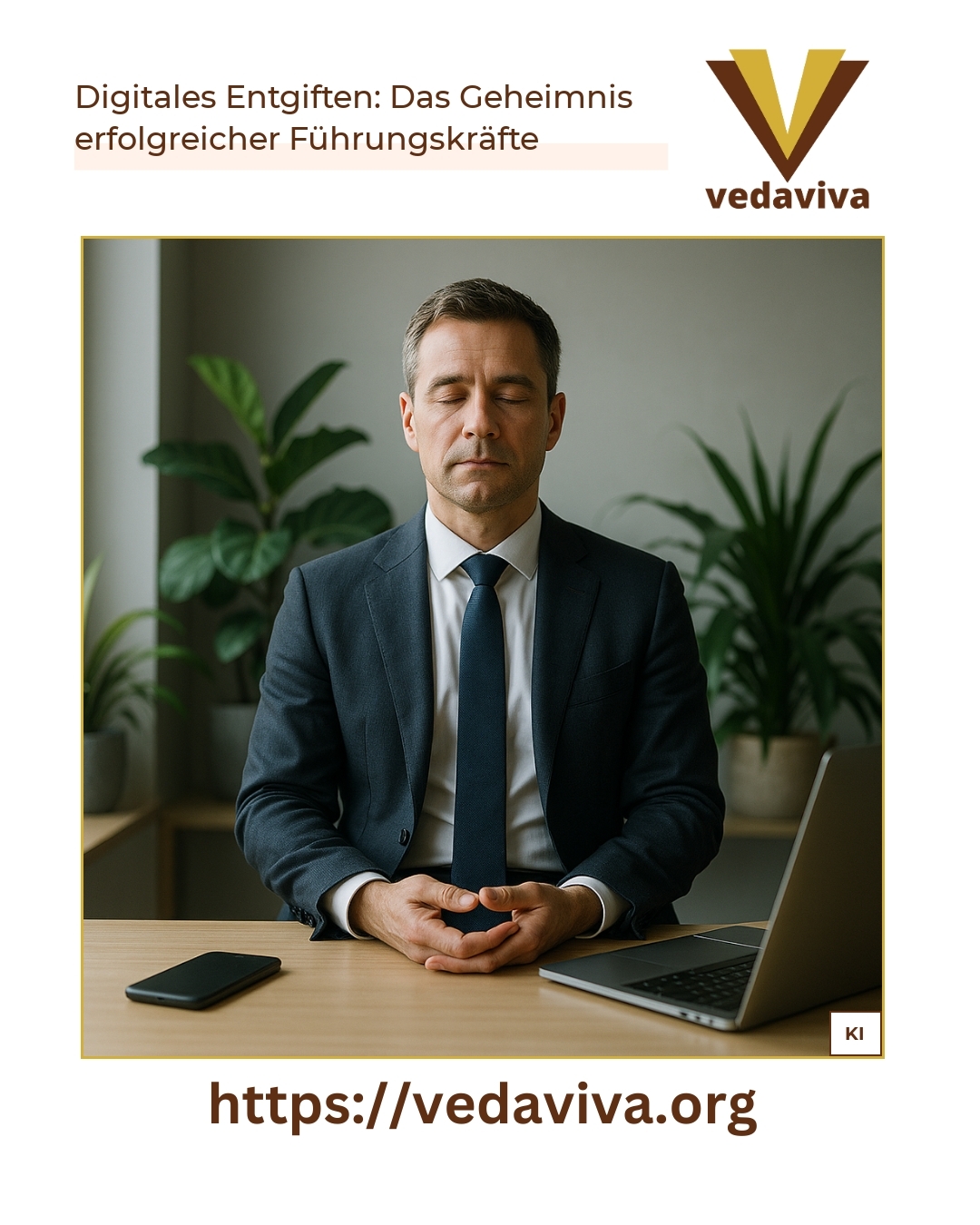Digital detox: Why modern managers consciously switch off
Permanent availability and constant digital distractions are part of modern management life. But more and more managers are realising this: Digitally detoxing is not a luxury, but a necessary strategy for long-term success. Around 60 per cent of managers regularly feel overwhelmed by digital information [1]. Digital detoxing helps to reduce this burden and sustainably improve your own performance and that of your team. In this article, you will find out how to integrate digital detoxing into your day-to-day management work and what benefits it offers.
What is digital detoxing and why is it important?
Digital detox describes the conscious renunciation or targeted reduction of digital media and devices [7]. It is not about condemning technology in principle. Rather, you learn to use these options responsibly. The always-on mode characterises our working world and leads to enormous stress. Digital detox is the conscious counter-movement to this constant networking and accessibility.
The Federal Ministry of Education and Research identified twelve digital stress factors in a study [9]. The main causes of digital stress are performance monitoring, the feeling of being constantly monitored and the unreliability of digital systems. These factors have a direct impact on your ability to work, productivity and job satisfaction. Digital detox helps you to minimise these stressors.
The effects of constant digital use
On average, people look at their mobile phones around 200 times a day [6]. This constant distraction fragments your attention and makes real relaxation impossible. Your brain can never really switch off. The consequences are sleep disorders, lack of concentration and increased irritability. Digital detoxing creates space for inner peace and real relaxation.
Managers are particularly affected. They constantly bear the burden of being available. Emails come in around the clock. Messages from the team are waiting to be answered. This constant stress leads to burnout and emotional exhaustion. Digital detoxification is therefore essential for your mental health and long-term performance.
Digital detox boosts creativity and focus
A key benefit of digital detoxing is the increase in creativity and concentration [8]. When you consciously distance yourself from your smartphone and laptop, your brain frees up space for new thoughts. Your head becomes clear again. You can concentrate on complex tasks without being constantly interrupted.
In the modern economy, creativity is a more valuable commodity than pure factual knowledge. Artificial intelligence and algorithms take care of routine tasks. Your ability to find innovative solutions sets you apart. Digital detoxing trains precisely this ability. Your brain needs breaks to be creative.
Focus and productivity through digital detoxing
Distractions significantly reduce productivity. If you fragment your attention, you need longer for each task. Digital detoxing helps you to get back into the so-called flow state. This is the moment when you are completely absorbed in a task. Your best ideas and work are created in this state.
Many successful managers have recognised this: Focused phases of work bring more than permanent multitasking. Digital detoxing allows you to get back to this state. The result is higher productivity in less time.
Promoting mental health through digital detoxification
Studies show: Managers who regularly practise digital detoxification suffer less from burnout [1]. They have greater emotional stability and better mental resilience. Digital detoxing therefore promotes your mental health and resilience to stress.
Your nervous system needs real rest. Otherwise it will remain permanently on alert. Digital detoxing signals to your body: it is now safe to shut down. Your stress level drops. You sleep better. Your mood improves. These effects are not only pleasant, but also measurable and sustainable.
Digital detox as a role model for the team
As a manager in particular, you have a role model function [15]. If you yourself are constantly available and constantly staring at screens, you are sending a clear message to your team: this is normal and expected. If, on the other hand, you practise digital detox and take breaks, you give your employees permission to do the same.
Many teams suffer from the expectation of constant availability. Digital detoxification at management level signals this: We are creating space for rest and relaxation. This not only increases team satisfaction, but also loyalty and the willingness to stay with the company for a long time.
Practical strategies for digital detoxing in day-to-day management
Deactivate push notifications
The first concrete step in digital detoxing is to switch off push notifications [2]. These little red dots and messages fragment your attention. They act like signals: look here now, something new has happened. This is one of the most powerful distraction mechanisms of modern technology. Switch off these notifications - for emails, social media and messaging services.
You can also define time slots for email checks. Only reply to emails at certain times, not all the time. The digital detox means being the master of your time again, not a slave to constant signals.
Establish screen-free times
Establish specific mobile phone-free times in your everyday life [3]. This could be the first thirty minutes after waking up. Or the last hour before going to bed. Or the lunch break. These digital detox breaks give your nervous system time to regenerate.
A practical tip: deliberately put your smartphone down away from you. Preferably out of your field of vision. Use an analogue alarm clock instead of a mobile phone alarm clock [3]. This physically separates you from the digital world and helps with digital detoxing much better than willpower alone.
Clean out and clear out your mobile phone
An important part of digital detoxing is decluttering your mobile phone [2]. You don't really need many apps. They are simply there to distract you. Delete apps that aren't really useful to you. Put apps like Facebook or WhatsApp in folders so that the annoying red notification dots disappear from your field of vision.
By decluttering, you reduce visual stimuli and mental stimuli. Digital detoxing often begins with this small but effective measure.
Track your digital usage
Before you change, you need to measure [10]. Track your digital usage for a week. Some smartphones already have built-in functions for this. Or use apps such as Moment or Space [2]. These show you exactly how long you spend online and which apps distract you the most.
The most important thing when detoxing digitally is awareness. Many people are so used to their digital use that they no longer even notice it. Tracking makes this unconscious behaviour visible. You can then make conscious decisions and organise your digital detox in a targeted way.
BEST PRACTICE at company XYZ (name changed due to NDA contract)
A medium-sized technology company introduced a company-wide digital detox programme. The managing director recognised that her management team was permanently exhausted and uncreative. She implemented the following measures: From 6pm, all email servers were blocked for employees. A digital detox programme started at midday on Friday, during which all devices went offline. Instead, there was time together for analogue activities. After three months, 78 per cent of managers reported better sleep quality and less stress. Productivity even increased by 12 per cent because employees got more done in more concentrated phases. The digital detox was therefore not a loss of productivity, but a gain.
Implementing digital detox in teams
Creating shared digital detox times
As a manager, you can establish digital detoxing in your team. Introduce common, device-free times [1]. This could be regular meetings without laptops. Or joint breaks in which all devices are put away. This promotes real personal communication and team collaboration.
Some companies introduce email-free periods, for example after 6 pm [3]. Others block emails at the weekend. These are concrete measures for digital detoxification at company level that signalise: We respect your quiet time.
Redesign workshops and meetings
Many meetings are characterised by distractions. Everyone has their laptop open, is working on emails or looking at their mobile phone. Digitally detoxing means explicitly creating space for personal interaction without digital devices [1]. Ban laptops in certain meetings. Use this time for real discussions and creativity.
This may sound radical at first, but many companies report that it is: These meetings are more productive and creative than before. Digitally detoxing therefore improves the quality of collaboration.
BEST PRACTICE at ABC (name changed due to NDA contract)
A large financial services company organised „digital detox workshops“. These were specifically designed for creative teams and strategy groups. The teams met at locations without Wi-Fi and mobile phone reception. There they worked on innovative projects. The first hour was typically frustrating - people felt „cut off“. But then something interesting happened: the conversations got deeper. Thoughts became clearer. After two days of such digital detoxes, 85 per cent of participants reported breakthrough ideas for their projects. The company then organised these workshops on a regular basis.
Tools and apps to support digital detoxification
It may sound paradoxical, but there are apps that help you detox digitally [2]. These tools make your usage behaviour transparent and help you to set limits.
Tracking and monitoring apps
Apps such as Moment and Space track precisely how long and how often you use your mobile phone [2]. They show you which apps distract you the most. With this clarity, you can make conscious decisions. Digital detox starts with data and awareness.
The Space app also offers the function of setting your own goals and analysing your behaviour [2]. You don't just see that you've been online for five hours. You can also see why: pastimes, games or social media. With this knowledge, you can make targeted use of digital detoxing.
Blocking and motivational apps for digital detoxing
Apps such as Offtime block certain applications or your entire network for periods of time that you specify [2]. This allows you to „force“ yourself to stay offline. The Forest app uses gamification: you plant a virtual tree that grows as long as you stay offline [3]. The longer your digital detox lasts, the more beautiful your tree becomes.













